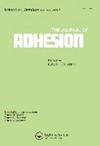Adhesion property of municipal solid waste incinerator bottom ash and limestone with asphalt based on surface energy theory
IF 2.3
4区 材料科学
Q2 ENGINEERING, CHEMICAL
引用次数: 0
Abstract
ABSTRACTThe aim of this paper is to investigate the adhesion of municipal solid waste incinerator bottom ash (MSWIBA) and limestone to asphalt using the principles of surface energy theory. MSWIBA asphalt mixes are known for their satisfactory water stability, with adhesion being a crucial factor, as demonstrated in previous freeze-thaw splitting tests. Contact angles of ground MSWIBA and limestone were measured using a capillary rise test, eliminating the influence of material surface structure. Subsequently, adhesion work and spalling work were calculated to correlate with water-induced damage. The results showed that the sequence of adhesion work was fine MSWIBA > limestone > coarse MSWIBA, while the sequence of spalling work was coarse MSWIBA > limestone > fine MSWIBA. The adhesion of MSWIBA asphalt mixes was evaluated using the water boiling test image method to validate the findings of surface energy theory. In both asphalt tests, the spalling rate followed this sequence: coarse MSWIBA > limestone > fine MSWIBA. The Adhesion index ER ranked as follows: ER Fine MSWIBA > ER limestone > ER coarse MSWIBA. These results suggest that the water stability of MSWIBA asphalt mixes is influenced by the surface energy of the components. Consequently, indices derived from surface energy theory can be applied in formulating and predicting the properties of MSWIBA asphalt mixes.KEYWORDS: Asphalt mixturemunicipal solid waste incinerator bottom ashsurface free energyadhesion workspalling work AcknowledgmentsThe research was financially supported by the National Natural Science Foundation of China (52008069) and Beijing Postdoctoral Research Foundation(2022-zz-054). The views in the paper only reflect those from the authors and may not necessarily reflect the views from the sponsors.Disclosure statementNo potential conflict of interest was reported by the author(s).Additional informationFundingThe research was financially supported by the National Natural Science Foundation of China (52008069) and Beijing Postdoctoral Research Foundation (2022-zz-054). The views in the paper only reflect those from the authors and may not necessarily reflect the views from the sponsors.基于表面能理论的城市生活垃圾焚烧炉底灰与石灰石与沥青的粘附性能研究
摘要本文运用表面能理论研究了城市生活垃圾焚烧炉底灰和石灰石对沥青的附着力。MSWIBA沥青混合料以其令人满意的水稳定性而闻名,正如之前的冻融劈裂试验所证明的那样,附着力是一个关键因素。采用毛细上升法测量了地面MSWIBA与石灰石的接触角,消除了材料表面结构的影响。随后,计算了附着功和剥落功与水致损伤的关系。结果表明:黏附效果为细粒MSWIBA >灰岩>粗粒MSWIBA,剥落效果为粗粒MSWIBA >灰岩>细粒MSWIBA。采用沸水试验图像法对MSWIBA沥青混合料的附着力进行了评价,验证了表面能理论的结论。两种沥青试验的剥落率顺序为:粗粒MSWIBA >石灰石>细粒MSWIBA。粘附指数ER的大小为:ER细粒MSWIBA > ER石灰石> ER粗粒MSWIBA。这些结果表明,MSWIBA沥青混合料的水稳定性受到组分表面能的影响。因此,由表面能理论导出的指标可用于MSWIBA沥青混合料的配方和性能预测。关键词:沥青混合料;城市固体垃圾焚烧炉底灰;表面自由能;论文中的观点仅反映作者的观点,不一定反映主办方的观点。披露声明作者未报告潜在的利益冲突。本研究由国家自然科学基金(52008069)和北京市博士后科研基金(2022-zz-054)资助。论文中的观点仅反映作者的观点,不一定反映主办方的观点。
本文章由计算机程序翻译,如有差异,请以英文原文为准。
求助全文
约1分钟内获得全文
求助全文
来源期刊

Journal of Adhesion
工程技术-材料科学:综合
CiteScore
5.30
自引率
9.10%
发文量
55
审稿时长
1 months
期刊介绍:
The Journal of Adhesion is dedicated to perpetuating understanding of the phenomenon of adhesion and its practical applications. The art of adhesion is maturing into a science that requires a broad, coordinated interdisciplinary effort to help illuminate its complex nature and numerous manifestations.
 求助内容:
求助内容: 应助结果提醒方式:
应助结果提醒方式:


